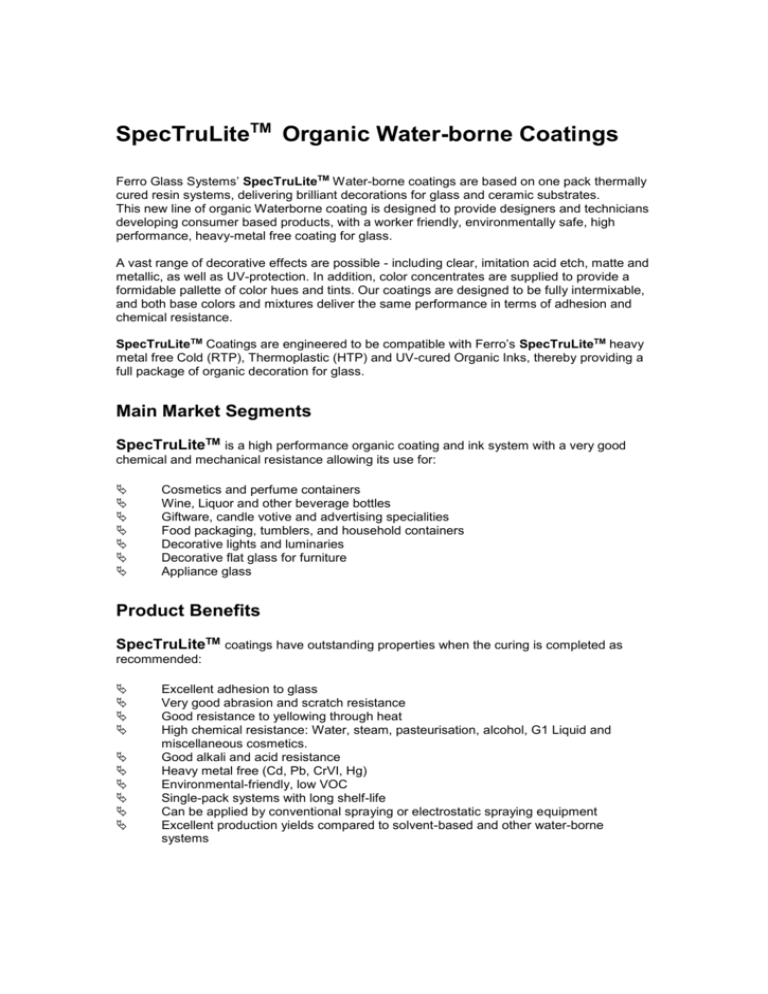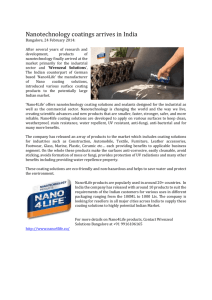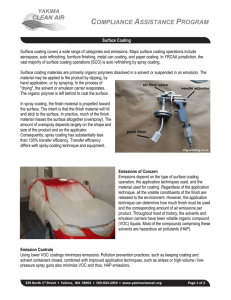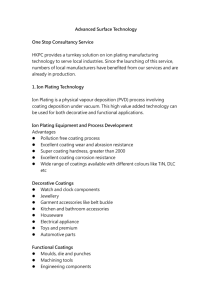SpecTruLiteTM Organic Water-borne Coatings
advertisement

SpecTruLiteTM Organic Water-borne Coatings Ferro Glass Systems’ SpecTruLiteTM Water-borne coatings are based on one pack thermally cured resin systems, delivering brilliant decorations for glass and ceramic substrates. This new line of organic Waterborne coating is designed to provide designers and technicians developing consumer based products, with a worker friendly, environmentally safe, high performance, heavy-metal free coating for glass. A vast range of decorative effects are possible - including clear, imitation acid etch, matte and metallic, as well as UV-protection. In addition, color concentrates are supplied to provide a formidable pallette of color hues and tints. Our coatings are designed to be fully intermixable, and both base colors and mixtures deliver the same performance in terms of adhesion and chemical resistance. SpecTruLiteTM Coatings are engineered to be compatible with Ferro’s SpecTruLiteTM heavy metal free Cold (RTP), Thermoplastic (HTP) and UV-cured Organic Inks, thereby providing a full package of organic decoration for glass. Main Market Segments SpecTruLiteTM is a high performance organic coating and ink system with a very good chemical and mechanical resistance allowing its use for: Cosmetics and perfume containers Wine, Liquor and other beverage bottles Giftware, candle votive and advertising specialities Food packaging, tumblers, and household containers Decorative lights and luminaries Decorative flat glass for furniture Appliance glass Product Benefits SpecTruLiteTM coatings have outstanding properties when the curing is completed as recommended: Excellent adhesion to glass Very good abrasion and scratch resistance Good resistance to yellowing through heat High chemical resistance: Water, steam, pasteurisation, alcohol, G1 Liquid and miscellaneous cosmetics. Good alkali and acid resistance Heavy metal free (Cd, Pb, CrVI, Hg) Environmental-friendly, low VOC Single-pack systems with long shelf-life Can be applied by conventional spraying or electrostatic spraying equipment Excellent production yields compared to solvent-based and other water-borne systems Basic Properties SpecTruLiteTM water-borne coatings are supplied in two different systems, branded as System 95 and System 84. System 84 is a new generation SpecTruLiteTM, with low VOC, excellent transparency and higloss. This System was originally developed for the European market and is especially recommended for perfume and cosmetic containers, and for transparent colors. System 95 is generally recommended for applications where dishwasher resistance is important (survives 150+ cycles in a typical domestic dishwasher test). Physical Properties Property System 95 System 84 Solids content V.O.C. Flash point Density Max.30% Max.10% > 60oC (145oF) 1.06+/- 0.03 40-45% 5% >60oC (145oF) 1.06+/- 0.03 Delivered Viscosity: Clear/color conc. 20 to 25 secs #4 Afnor Cup (24oC/ 75oF) 15 to 20secs #3 Zahn Cup (24oC/ 75oF) 20 to 25 secs #4 Afnor Cup (24oC/ 75oF) 15 to 20 secs #3 Zahn Cup (24oC/ 75oF) Delivered Viscosity: Frost, Matte 25 to 35 secs #4 Afnor Cup (24oC/ 75oF) 20 to 25 secs #3 Zahn Cup (24oC/ 75oF) 25 to 35 secs #4 Afnor Cup (24oC/ 75oF) 20 to 25 secs #3 Zahn Cup (24oC/ 75oF) Film Properties Property System 95 System 84 Pencil Hardness Cross-hatch Adhesion Alcohol double rubs MEK double rubs 48hr water-soak at room temperature 21oC (70 oF) 24hr cold water soak 3oC (37 oF) 24hr soak G1 liquid 23oC (73oF) (L’Oreal test) 24hr soak in ethanol > 2H 0% loss 50+ 50+ Pass > 2H 0% loss 50+ 50+ Pass Pass Pass Pass Pass Pass Pass Recommendations for Use Substrate cleanliness Like any high quality surface coating, the cleanliness of the substrate is extremely important. Dirt, dust, fingerprints, fat, wax, etc. on the ware or in the workplace environment, can cause surface defects or performance problems. Of particular concern are the presence of cold end coatings on glass containers. Cold end coatings based on polyethylenes, soaps, oleic acid are known to cause either obvious wetting problems - where the decorative coatings tend to “bead up” on the ware - or adhesion problems with the cured coating. This is likely to occur when the cold end coatings are heavily applied. The SpecTruLiteTM coating often adheres to the cold end coating but the glass/cold end coating interface fails, particularly when the ware has been exposed to water. Therefore, it is strongly recommended that either no cold end coating, or a light application of stearate cold end coating is used. Oleic acid based and polyethylene cold end coatings should be avoided. If you are not sure of the coating applied on the substrate, it can be removed by running it through a lehr set at a typical glass enamel profile. This should be operated at a temperature of at least 450°C (800°F) for at least 30 minutes. Substrate preparation If the glass has impurities on its surface, a suitable surface preparation technique should be used to ensure maximum quality: A flame pre-treatment with a propane gas burner or heating the piece can be used, provided the glass temperature does not exceed 25°C during the application of the coating Alkaline cleaners or waterborne surfactants in a temperature range of 20°C to 80°C, can be used to clean the glass Ionised air can be blown onto the glass just before coating, to avoid dust collection on the surface The surface preparation technique to be used is dependent on the application. Product Thinning The product is supplied set up at a ready-to-use viscosity for spraying, dipping or flowcoating; however, depending on application equipment, thinning may be necessary. Distilled or de-ionized water is recommended for thinning. Do not use tap water as the salts in it may cause small lumps to form or may cause water sensitivity of the cured film. The water should be added slowly while the coating is under constant agitation, and then stirred gently for about five minutes to assure uniformity, whilst avoiding whipping air into the mix. If more than 15-20% water is needed to thin for your application, please contact your local Ferro sales office for more information and technical advice. Delivery Viscosity : SpecTruLite Frost SpecTruLite Clear/color concentrate 25” - 35” / Afnor Cup n°4 20” - 25”/ Afnor cup N°4 Thinning : Distilled (Deionised) water Application instructions SpecTruLiteTM is a one component, ready to use waterborne coating. The product is supplied ready-to-use and no customer mixing of resins, curing agents or additives is necessary prior to application. If thinning is required for any application, a small addition of deionised water is all that is needed. The coating may be applied in a variety of methods including spraying, dipping, and brushing. Viscosity can be adjusted to achieve a wide range of coating thicknesses. We have found that an HVLP (High Volume/Low Pressure) type spray gun works much better than the older types that use higher air pressure. Higher spray viscosity can then be used and the sprayed object looks wetter, which leads to higher gloss. Our products can also be applied by wet electrostatic spraying, using aerobell or disc. Recommended Spraying Viscosity : SpecTruLite Frost SpecTruLite Clear/color concentrate Thinning : Filter sizes: SpecTruLite Frost SpecTruLite Clear/color concentrate Spray Nozzle size : Hand held gun Automatic machine Atomisation pressure : Paint pressure : Curing : For High resistance standards Average dry film thickness : Dry film Quality control : Recommendations : 25-35 secs. / Afnor Cup n°4 (24°C/75°F) 20-25 secs. / Zahn Cup n°3 (24°C/75°F) 20-25 secs. / Afnor cup n°4(24°C/75°F) 15-20 secs. / Zahn Cup n°3 (24°C/75°F) Deionised water : Maximum thinning ratio: 20% Fineness : Fineness : > 50 micrometers < 15 micrometers 0.5 – 1.5 mm diameter 0.5 – 1.0 mm diameter Depending on application: 2– 4 bar Max. 1 bar Temperature: 200°C (392°F) glass temperature Time: 15 minutes minimum Flash-off: approx. 2-3 mins. 8 -15 microns Rub the cured film with a rag soaked in a strong solvent (MEK). An undercured film will be removed by the solvent Paint tends to settle with time so a thorough mixing before spraying should be planned Freshly applied film is opalescent and will obtain its final appearance, transparency and gloss, after curing Heat up time depends on glass thickness Make sure the equipment doesn’t react with water and non-rusting or anticorrosion steel is used Membrane pumps made of stainless steel or polypropylene are recommended The compressed air must be free of oil Immediately after use, wash the guns and the alimentation system with demineralised water Drying and curing As the water evaporates from the applied coating the polymer particles, aided by a small amount of slow evaporating solvent, coalesce into a continuous film. After the film is formed it must be chemically crosslinked by heat. No subsequent curing at room temperature will take place . For complete curing and for high standards resistance, the coating and the substrate must reach a temperature of about 200°C (392°F). In forced air ovens and Lehrs a recommended starting point is 20 minutes at 200°C (392°F). This has usually been effective in allowing the ware to reach the necessary temperature for complete curing. The residual heat in the ware after it leaves the active heating zone in a Lehr will continue to cure the coating. The actual time necessary to cure the coating is dependent on the heat transfer rate of the oven or Lehr and the size, shape, and thickness of the ware. Infrared ovens can allow faster cross linking cycles of the coating, and hence shorter cycle times. Like any heat cured coating with volatile components, it is possible to cause blistering if the wet film is heated so fast that the surface begins to cure before all the underlying volatile materials are removed. When fully cured, the coating has a pencil hardness of 2-3H. A quick and easy test to determine how well the coatings are cured is to put a strong solvent like methyl ethyl ketone (MEK) on a rag or paper towel and rub the cured film. An under-cured coating will be removed by the solvent, with its sensitivity to the solvent being reduced as it more fully cured. Other firing cycles are possible according to the required chemical-mechanical properties. Any firing cycle chosen should be checked on the specific installation under normal production conditions. Recommended cure Flash-off cycle 2-3 mins. 200°C (392°F) glass temperature For 20 min. High Standard Cleanup While the coating is wet, it can be cleaned up with mild soap and water. An alkaline cleaner, e.g. Windex 409, Fantastic, or similar works very well. Where the coating has dried but not cured, it may be necessary to use a strong polar solvent like acetone or MEK. Most glycol ether solvents are effective but may require a brief soaking period. Conventional paint thinners, mineral spirits, and turpentine are not recommended. Storage conditions The shelf life of the coating in its original container is around 6 months, dependant on storage conditions. When stored correctly, in sealed containers, away from direct heat and at a temperature between 5°C(41°F) and 45°C(113°F), shelf life can be > 6 months. Safety Information This product does not require any special labelling, but we recommend referring to the product safety sheet before handling. Available Product Range and Colors SpecTruLiteTM water-borne coatings are supplied in two different systems, branded as System 95 and System 84. System 84 is a new generation SpecTruLiteTM, with low VOC, excellent transparency and higloss. This System is especially recommended for transparent colors and for perfume and cosmetic containers. System 95 is generally recommended for applications where dishwasher resistance is important (survives over 150 cycles). SpecTruLiteTM coatings are available in a vast range of colors and special effects: Standard Base Coatings SpecTruLiteTM Base Clear 95-001: Transparent and glossy SpecTruLiteTM Base Clear 84-0001: Super-Transparent and hi-gloss SpecTruLiteTM Base Frost 95-000: Translucent, matt, imitation acid etch SpecTruLiteTM Base Frost 84-0000: Translucent, matt, imitation acid etch SpecTruLiteTM Base White 95-900: Glossy Opaque White SpecTruLiteTM Base White 95-901: Matt Opaque White SpecTruLiteTM Base White 84-9000: Glossy Opaque White SpecTruLiteTM Base White 84-9001: Matt Opaque White SpecTruLiteTM Standard Color Concentrate Coatings : Color Red Red (Bluetone) Yellow Black Green Blue Turquoise Blue Violet System 95 95-100 95-133 System 84 84-1100 84-1101 95-300 95-400 95-600 95-700 84-3100 84-4100 84-6100 84-7100 84-7101 84-8100 95-702 SpecTruLiteTM Special effects : Fluorescent, Metallic (Gold, Silver, Copper, Pearl, Chrome), Interference effects, UV-blocking……… SpecTruLiteTM Fluorescent Coatings: Color Bright Red Red Pink Tangerine Magenta Orange Yellow Green Blue Violet System 95 Coating Fluo 96-1000 Coating Fluo 96-1002 Coating Fluo 96-1003 Coating Fluo 96-1004 Coating Fluo 96-1005 Coating Fluo 96-1008 Coating Fluo 96-3000 Coating Fluo 96-6000 Coating Fluo 96-7000 Coating Fluo 96-8000 System 84 Coating Fluo 86-1100 Coating Fluo 86-1102 Coating Fluo 86-1103 Coating Fluo 86-1104 Coating Fluo 86-1105 Coating Fluo 86-1108 Coating Fluo 86-3100 Coating Fluo 86-6100 Coating Fluo 86-7100 Coating Fluo 86-8100 Available Product Range and Colors (cont….) SpecTruLiteTM Metallic Coatings: Color Yellow Gold Red Gold Silver Chrome Pearl Copper System 95 Coating Metallic 97-1000 System 84 Coating Metallic 87-1000 Coating Metallic 97-1001 Coating Metallic 97-2000 Coating Metallic 97-2001 Coating Metallic 97-4000 Coating Metallic 97-5000 Coating Metallic 87-1001 Coating Metallic 87-2000 Coating Metallic 87-2001 Coating Metallic 87-4000 Coating Metallic 87-5000 Color Mixing and Matching With SpecTruLiteTM waterborne coatings, decorators and designers can make an almost infinite range of colors and effects, from hi-gloss clears to colored imitation acid etches and metallic effects. Colors can be applied singly or in combination, as an all-over even finish or to deliver diffused flow-out effects. The possibilities are almost endless. The bases, standard color concentrates and special effect colors are supplied as intermixable colors to help you achieve the effect you require. Each product and concentrate is by itself a finished coating that can be used as supplied, or it may be mixed with any other coating to create the effect and color desired. For example: To achieve a colored transparent, a good starting point is 25% of color concentrate plus 75% of base clear. To achieve an opaque color, combine a transparent mix (color concentrate + base clear) with a base white concentrate. To achieve a colored frost, we recommend to start with a mix of 5% color concentrate plus 95% base frost. The amount of shear required for effective mixing is very low. Therefore, care should be taken during mixing to ensure that excess air is not pumped into the mix, which may cause pinholes in the final cured surface. For those customers who prefer not to make their own color matches, tailor-made products and a full color matching service are provided.






